The Haji Ali Dargah is one of Mumbai’s most iconic landmarks and must not be missed. It is not merely a Dargah or a tourist attraction; it is an entirely different experience.
Despite the constant bustle, there is an aura of tranquility while entering the monument. Whichever religion you practice, this place welcomes you with open arms.
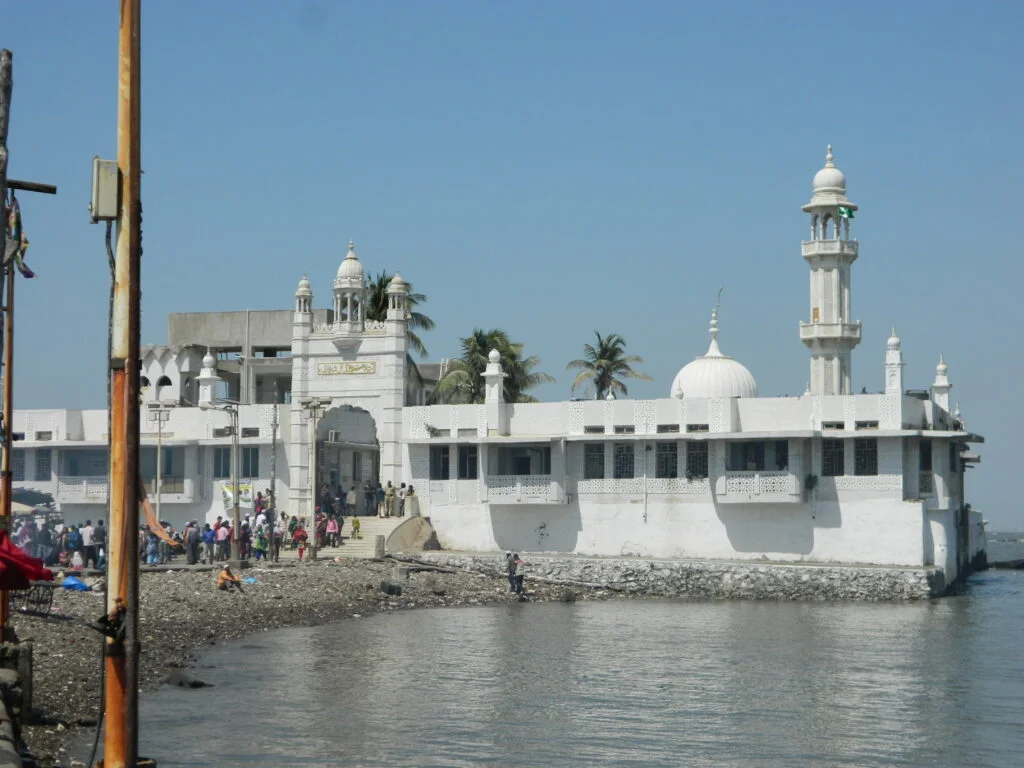
What is the story behind Haji Ali Dargah?
The Haji Ali Dargah dates back to 1431 and is affiliated with Sayyed Pir Haji Ali Shah Bukhari.
He was a prosperous trader from Bukhara (modern-day Uzbekistan) who forsook his wealth and worldly belongings to travel to Mecca for the pilgrimage.
Following that, he traveled the globe before settling in Mumbai.
The Dargah was placed under the auspices of the Haji Ali Dargah Trust in 1916. A sanatorium and an entrance gate were constructed for the complex in 1950.
Later the same year, in 1964, the mosque and Dargah Sharif received extensive repairs and reconfigurations.
By 1990, the small pathway leading to the masjid had also been rebuilt. After extensive rebuilding, the entire site now comprises a 5000-square-meter footprint.

Miracle of the Pir Haji Ali Shah Bukhari or Baba Haji Ali
According to legend, the saint once witnessed a woman weeping on the road after accidentally spilling the oil she was carrying.
He felt sorry for her and pressed his finger against where she’d spilled the oil. Oil seeped from the dirt, and the woman happily refilled her oil vessel and returned home.
However, the saint had a terrible dream that his conduct had caused harm to the land. This plagued him with regret, and his health suffered as a result.
That was during his visit to India. When he arrived on the Mumbai shore, he intended to stay permanently and spread Islam among the people.
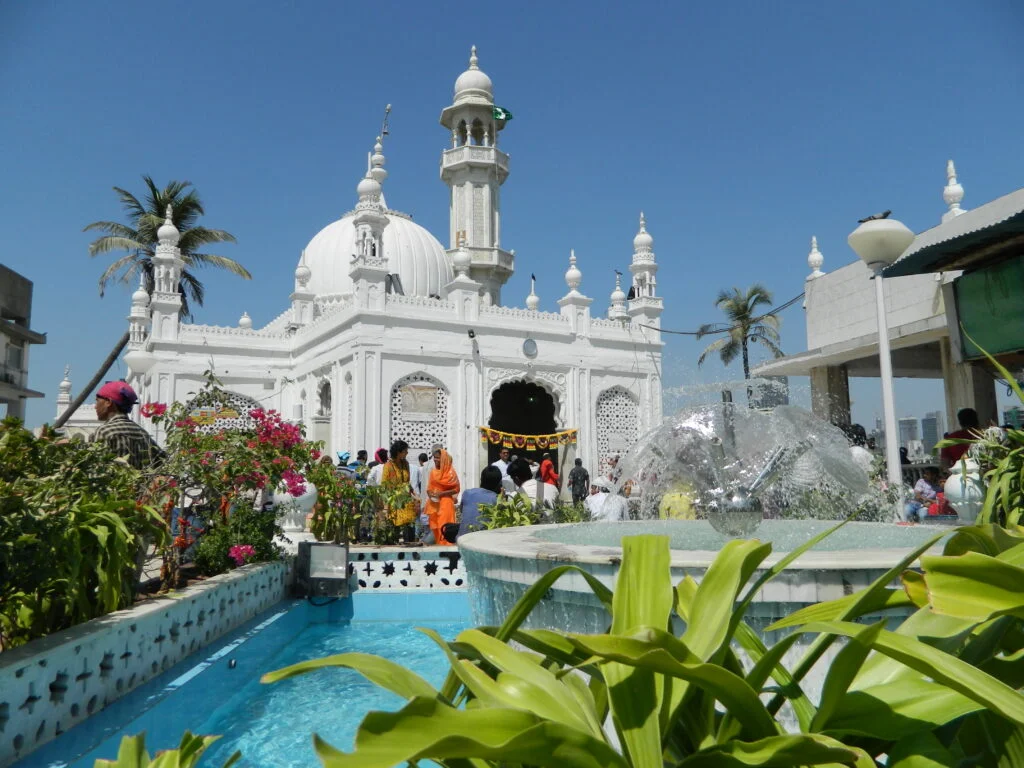
The demise of the Pir
There are also other legends about his demise. According to the most prevalent version, the saint instructed his devotees not to bury him immediately after death.
He directed them to toss his casket into the water and bury him where it was discovered. His companions obeyed, and his coffin was deposited on a little mound in Worli.
Later, the dargah and the saint’s tomb were constructed on the same site. Over time, the grave became a famous pilgrimage destination for pilgrims seeking blessings.
Timings
This mausoleum is open to tourists seven days a week from 5:30 a.m. to 10 p.m. Visitors are not required to be Muslim to enter.
Nonetheless, when you visit this dargah, you will primarily encounter believers of the Islamic faith.
There is no admission price; however, donations are welcome. A portion of the Trust’s income is used to maintain Madrasas (Islamic schools) and provide scholarships.
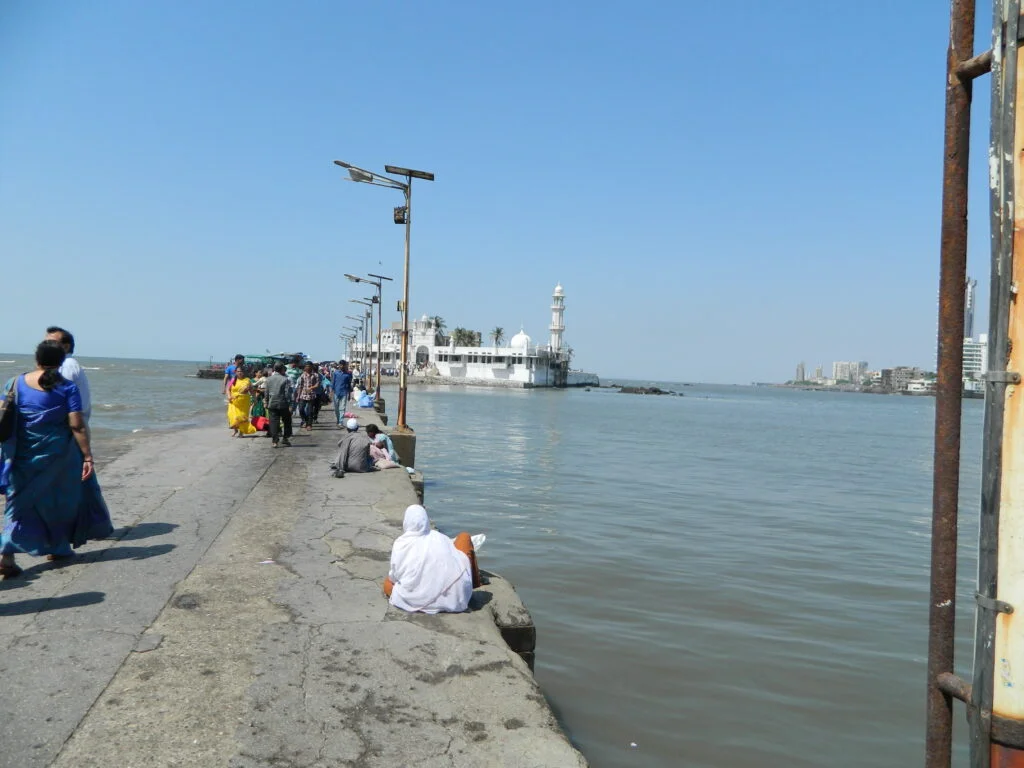
How to reach Haji Ali Dargah?
Visitors can reach Haji Ali Dargah using one of the numerous modes of local transport accessible in Mumbai – The metered black and yellow (Kali-Peeli) taxis, B.E.S.T. city buses, or local railways.
Auto rickshaws operate exclusively in Mumbai’s suburbs and will not travel to Haji Ali. When getting into the city from the suburbs, one must take a different form of transit than Mahim / Sion.
Rail
Local trains are one of the most convenient ways to Reach Haji Ali since it is well-connected. One must get off the Western line at Mahalakshmi Station or Mumbai Central Station, whereas one must get off on the Central (Main) line at Byculla Station and take a B.E.S.T. bus or taxi to the destination.
Road
Haji Ali is also well-connected to the rest of Mumbai via the arterial route connecting the southern and western suburbs. To get to Haji Ali from the airport or the Western Suburbs, one must travel along L. J. Road, Shivaji Park, Prabhadevi, Worli, or via the Sea-link to Worli along Lala Lajpat Rai Marg (also known as Hornby Vellard) until they reach Haji Ali.
Those traveling from the Central Suburbs / Navi Mumbai will take the Eastern Express Highway through Ghatkopar, Chembur, and Kurla. Through Sion, Matunga, Dadar, and then cross over into Prabhadevi, Worli, they will take the Sea-Link to Worli and then take Lala Lajpat Rai Marg (also known as Hornby Vellard) to get to Haji Ali.
The B.E.S.T. bus transports
Many buses to and from various locations throughout the city and suburbs via Haji Ali. Route numbers 33, 37, 63, 81, 83, 84, 85, 87, 89, 92, 93, 124, 125, 351, 357, 385, and 521 are some of the most popular.
To get to Haji Ali from South Mumbai, choose the Pedder Road, Breach Candy, Nana Chowk routes, Tardeo or Byculla routes, or the Mahalakshmi Race Course route (see below).
Uber and OLA services are also available – You can book a cab using the App on a smartphone, and the driver will take you directly up to the gate of the Dargah.
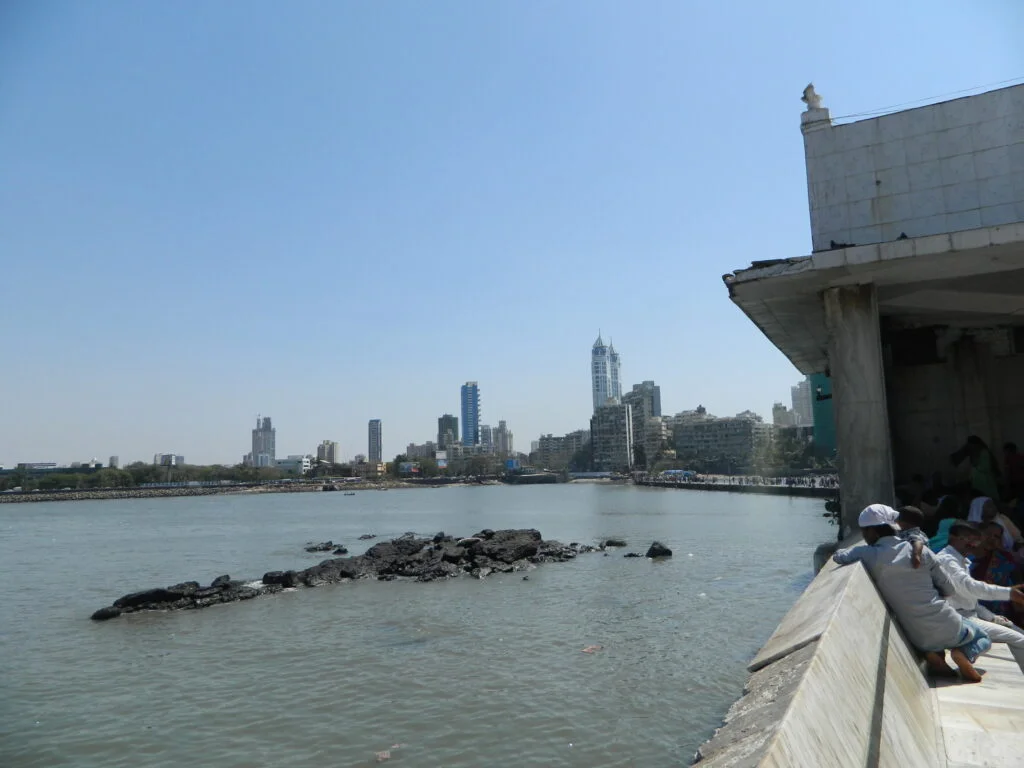
Who is the owner of Haji Ali?
The Trust was established under the Bombay Public Trust Act, 1950, and registered under the registration number PTR No. B-251 of the Bombay Public Trust Act, 1950. (B.O.M.).
Mumbai’s patron saint, Pir Haji Ali Shah Bukhari (R.A.), is buried at Haji Ali Dargah. The Haji Ali Dargah Trust administers and manages the tomb on the sea’s edge and appears in the middle of the Ocean.
The Haji Ali Dargah Trust was established in 1916 by Abdul Karim Haji Essa Haji Fazla, Haji Jan Mohamed Haji Mohamed, and other Cutchi Memons. They filed suit in the High Court of Judicature at Bombay, Ordinary Original Civil Jurisdiction, to establish the Haji Ali Dargah.
A scheme was established under the supervision of the Commissioner of the Hon’ble High Court for the management and administration of the Dargah and the associated properties.
The Haji Ali Dargah Trust was established as a charitable organization. Because India attained independence and sovereign status in 1947, the Haji Ali Dargah Trust was established and registered with the Charity Commissioner of Maharashtra following the provisions of the Bombay Public Trust Act 1950.
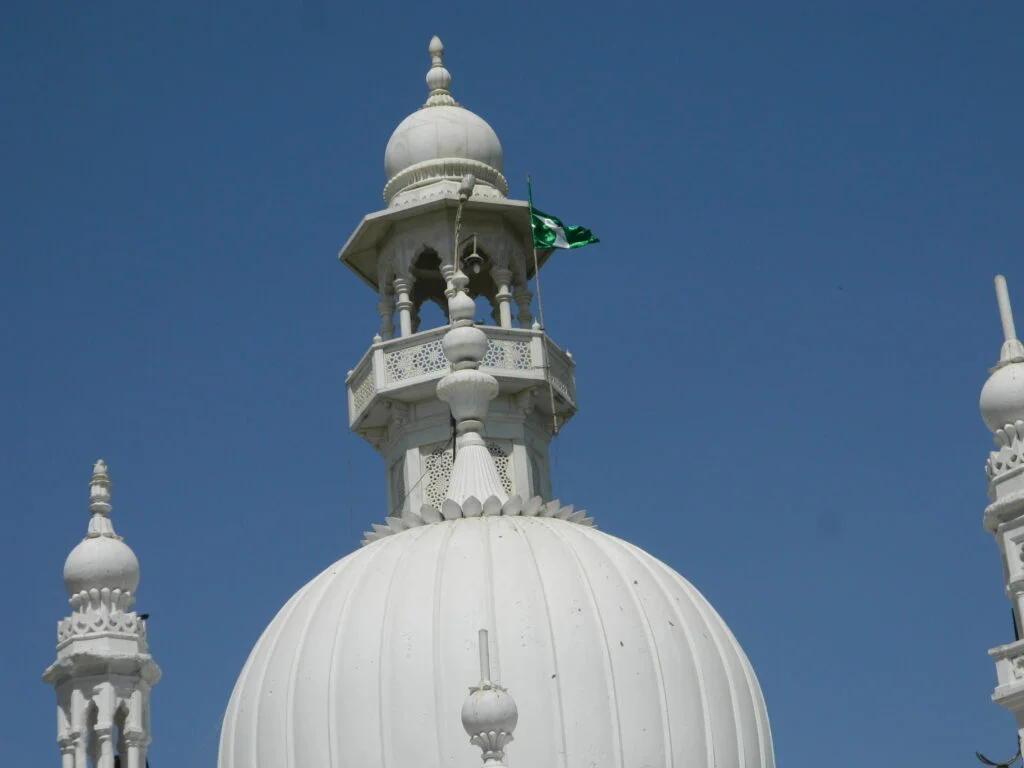
Facts and why it’s popular
- Whereas certain world regions are religiously divided, others are secular and liberal. The popularity of the Haji Ali Dargah in Mumbai demonstrates the latter, with thousands of people flocking to the sacred site regardless of caste, creed, or religion.
- With a footfall of 15,000 to 18,000 over weekdays and roughly 50,000 visitors on Thursdays and Saturdays, Haji Ali has become an iconic tourist spot over the years.
- Built-in the 19th century, this sought-after destination in Mumbai is the tomb of Saint Pir Haji Ali Shah Bukhari.
- Haji Ali, which floats amid the sea, has a unique origin story. Haji Ali Shah Bukhari forsook all earthly goods and converted to Islam before embarking on a journey to Mecca. In 1431 AD, the masjid and Dargah were constructed.
- This monument is an architectural marvel, combining Indo-Islamic and Mughal styles. TheDargahh is constructed of ‘Makrana’ marble, the same whitish marble used by Emperor Shah Jahan to build the Taj Mahal.
- Haji Ali is home to two major monuments: Pir Haji Ali Shah Bukhari’s mausoleum and a mosque. Its architecture is a direct descendant of the Mughal era.
- The kaleidoscopic patterns enhance the monument’s exquisite and royal appearance on the marble pillars and the mirror work. The structures, which are 400 years old, are corroding in numerous locations.
- The mosque has lasted approximately 400 years, surviving storms and the ravages of time. During the 1949 floods, when Mumbai faced the sea’s wrath, Haji Ali remained unharmed. Miraculously, the pilgrims and guests within the dargah, convinced they would drown in the floods, escaped unscathed.
- What’s more remarkable about Haji Ali is that it has stayed pothole-free for the entirety of its existence, despite being built on the seaside. Whereas Mumbai is awash with discussions and disputes about potholes, the dargah has miraculously lasted all these years.
Is there a dress code for Haji Ali?
Dress modestly, with shoulders and knees covered. While international tourists don’t need to wear a Salwar or Burqa while visiting the mosque, it is a good idea to do so to exhibit respect. If you are a lady, carry a shawl or scarf to conceal your head. Long cotton pants are an excellent option for men.
- While wearing long pants with a loose-fitting, long-sleeved shirt is permitted, women must cover their heads with a shawl/scarf.
- If you do not own a head covering, the mosque may be able to lend you one for the duration of your visit. Additionally, you can purchase one from neighboring shop stalls.
- Loose, light cotton clothing is recommended, as it can get extremely hot between March and June.
- If you’re traveling with children, let them wear anything they like; avoid excessive logos or graphic clothing.
Etiquette and instructions when visiting Haji Ali
- Bear in mind the timing of your visit to the monument. The path gets submerged during high tides, obstructing access to the monument. It is preferable to inquire about it in advance to avoid inconveniences. There are no railings along the pathway. Maintain a constant awareness of your surroundings. There is a chance that you will slip along the route.
- Enter through the entryway that corresponds to your sex. While it may appear strict, it is necessary to respect the norms when traveling with a companion of the other sex.
- If you are a female, enter the mosque and prayer hall through the west side entrance. If you are a man, enter on the south side. There will almost certainly be ushers directing you to the proper entrance.
- Remove your shoes before entering the dargah. Locate a shoe rack or tiny area adjacent to the door to store your shoes. If desired, additional personal belongings can be stored there, but it may be safer to bring them with you. As a gesture of gratitude, tip the people at the entryway for Rs.5 (6 cents USD) when you receive your shoes back. While small bags and purses are permitted within the mosque, hiking backpacks and other bulky luggage items should be left outside.
- Set your phone to silent mode or shut it off entirely. Respect that this is a sacred space by turning off your phone. Disruptive ringing and texting insult the saint and other Muslims, so keep your phone in your pocket and avoid taking it out. If you bring your phone in and it rings, you may receive unfavorable looks and may even be asked to leave.
- Offer prayers, flowers, and a chador to the saint to gain his blessings. Purchase fresh flowers or chadar (cloth coverings) from a nearby vendor and give them to Baba Pir Haji Ali’s tomb as an offering.
Prepare for someone standing close to the tomb to sweep your shoulders and head with a feathered broom. Concentrate on being present and receptive to the blessing to demonstrate respect and make it more joyful.
On your way out, if you have a Mauli (a red fabric bracelet), you can tie it to the Grilled gate in the center of the prayer hall between the two doors. Outside the shrine, some vendors selling chador have been quite aggressive in their sales practices, so be prepared for that.
Any other information
Best Time to Visit: Mumbai has beautiful weather throughout the year. Except for the summers, the climate is relatively stable. However, the best time to visit is between July and April. Throughout this period, you will be reasonably comfortable.
Important Events
- URS: Pir Haji Ali Shah Bukhari’s (R.A.) U.R.S. (Death Anniversary) occurs on the 16th of (Rabi-ul-Aakhir / Rabi-al-Thaany) (17th Shab). According to its objectives, the Trust performs all obligatory Islamic ceremonies and distributes Niyaaz (Food / Sweets) to all devotees & visitors.
- On the 16th of each Islamic month, following Namaaz-e-Isha (17th Shab), a special program of Milad and prayers is held in commemoration of Pir Haji Ali Shah Bukhari’s U.R.S. (R.A.). The Trust to everybody present distributes Niyaaz.
- Eid-E-Milad-un-Nabi: To commemorate Eid-E-Milad-un-Nabi – the 12th Rabi-al Awal (Birth Anniversary of Prophet Mohamed (S.A.W.S.), the Trust hosts a viewing of the Prophet’s holy relics following Namaaz-e-Zuhr. At dusk (Maghrib), prayers are offered (Fateha), and Niyaaz is distributed.
Official Website of HAJI ALI DARGAH TRUST
What attractions are near Haji Ali Mosque?
Famous Places Nearby:
Mount Mary Church Bandra – The Basilica of Our Lady of the Mount, commonly known as Mount Mary Church, is a Roman Catholic Basilica in Bandra, Mumbai. Even though the church tower is 100 years old, the history of the current statue of Our Lady dates back to the 16th century when Jesuit priests from Portugal got the figure to the present place and built a chapel.
Girgaon Chowpatty – The Girgaon Chowpatty Girgaon Chowpatty Beach can be a local spot to explore and the most famous beach in Mumbai. The beach is a popular destination for massages, yoga, and strolls at a leisurely pace.
It’s also a popular spot for those looking to relax with their family and friends after work. You can relax on the beach, sipping hot tea, bhelpuri, and panipuri while watching the sunset on the Arabian Sea.
Chhatrapati Shivaji Terminus – Chhatrapati Shivaji Maharaja Terminus is one of the most important railway stations connecting Mumbai with other national regions. In addition to its importance in the commercial world, It’s a landmark structure constructed in the Victorian-Gothic style.
It was previously known as Victoria Terminus. British engineers and Indian artisans worked for a decade to construct this structure.
Gateway of India – This stunning stone arch overlooked the Arabian Sea and was built to commemorate the first visit by King George V and Queen Mary. It is among the most popular spots for a visit to Mumbai for the people of Mumbai who visit to stroll around or watch the ferries that enter and leave the harbor.
It is also known as the Gateway of India and is the location for many luxurious boat excursions. It is a must-visit location for any Tourist who comes to Mumbai.
Taj Mahal Hotel – The most famous and Prestigious luxurious Taj Mahal Hotel is situated opposite the structure of the Gateway of India.
Marine Drive – Another famous attraction in Mumbai where you can sit beside the sea or walk on the promenade. It’s where you will see couples, Children, and early morning walkers enjoying the fresh sea breeze.
Chhatrapati Shivaji Maharaj Vastu Sangrahalaya – is around 5 km from Marine Drive.
Jehangir Art Gallery – is a famous art gallery only 5 km from Marine Drive.
Flora Fountain – in Fort is another famous structure between Marine Drive and the Gateway of India. It is just a water fountain with an exciting history and landmark in Mumbai.


Leave a Reply